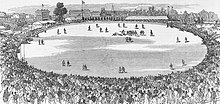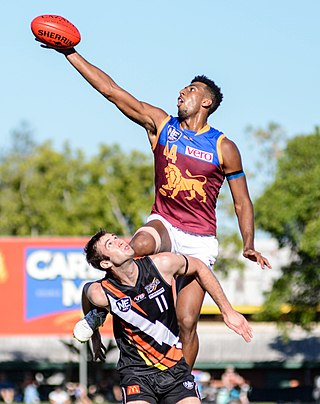
Australian rules football, also called Australian football or Aussie rules, or more simply football or footy, is a contact sport played between two teams of 18 players on an oval field, often a modified cricket ground. Points are scored by kicking the oval ball between the central goal posts, or between a central and outer post.

Football in Australia refers to numerous codes which each have major shares of the mainstream sports market, media, broadcasting, professional athletes, financial performance and grassroots participation: Australian rules football, rugby league, rugby union and soccer. There are four pre-eminent professional football competitions played in Australia: the Australian Football League, the National Rugby League, Super Rugby and the A-League (soccer). Rugby League is the most watched sport in Australia based on television viewership, however, Australian football attracts larger live attendences. In the states of New South Wales and Queensland, rugby football is overall the most watched and receives the most media coverage, especially the Rugby League State of Origin contested between the two states referred to as "Australian sport's greatest rivalry". In recent times, there has been an increase in popularity in Australian football and corresponding decrease in popularity of Rugby union in New South Wales and Queensland. Soccer, while extending its lead in participation rate, particularly in the large cities, and improving its performance at the FIFA World Cup and at the FIFA Women's World Cup, continues to attract the overall lowest attendance, as well as media and public interest, of the four codes.
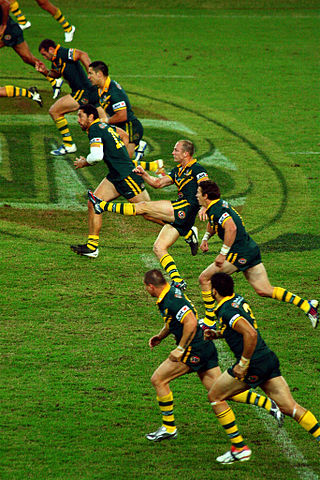
In Australia, rugby league is a popular spectator and participation sport which has been played since 1908. It is the dominant winter football code in the states of New South Wales and Queensland. According to Ausplay in 2024, there were 174,343 adult and 93,287 children playing it across five states at a participation rate of 0.8% per capita. Just under half of adult players are female. It is governed by the Australian Rugby League Commission based in Sydney.

Representative matches in Australian rules football are matches between representative teams played under the Australian rules, most notably of the colonies and later Australian states and territories. Senior intercolonial representative matches took place from 1879 to the turn of the 20th century. For most of the 20th century, the absence of a national club competition in Australia meant that interstate matches were regarded as important events.

Sport is an important part of Australia that dates back to the early colonial period. The first of the country's mainstream sports to become organised in order of establishment were cricket, Australian rules football, rugby union, tennis, association football and basketball and rugby league. Sport has shaped the Australian national identity through events such as the Melbourne Cup and the America's Cup.
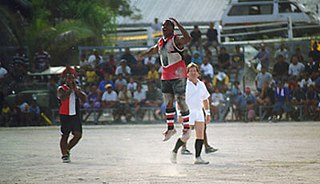
Australian rules football is played in more than 60 countries around the world with approximately 1.4 million players worldwide. By 2017 more than 26 nations had contested the Australian Football International Cup, the highest level of worldwide competition. The AFL Commission is the world governing body which manages international competition through its International Development Committee headed by Andrew Dillon. There are 3 regional governing bodies affiliated to the AFL: AFL Asia, AFL South Pacific and AFL Europe.

In Queensland, Australian rules football dates back to the colonial era in 1866, with organised competitions being continuous since the 1900s. Today, it is most popular in South East Queensland and the Cairns Region. There are 11 regional club competitions, the highest profile of which are the semi-professional Queensland Australian Football League and AFL Cairns. It is governed by AFL Queensland. According to Ausplay there are 51,941 adult players with a per capita rate of 1.2%, just under half of which are female, and 30,563 children. It is the seventh most participated team sport and fourth code of football after soccer, touch and rugby league.

Women's Australian rules football, is the female-only form of Australian rules football, generally with some modification to the laws of the game. It is played by more than half a million women worldwide and with 119,447 Australian adult and 66,998 youth female participants in 2023 is the second most played code among women and girls in Australia behind soccer.

Winter sports in Australia encompasses a great variety of activities across the continent of Australia, including winter sports played in snow and ice such as ice hockey. Climate varies considerably from the tropical North to temperate South in Australia, and sporting practices vary accordingly. Ice and snow sports like Skiing in Australia are conducted in the high country of the Australian Alps and Tasmanian Wilderness. Australia has relatively low mountain ranges, but a long history of participation in recreational skiing and the Winter Olympic Games. Australians have won olympic gold in ice skating, skiing and snow-boarding events. Australia's generally flat geography and usually mild winter climate otherwise provide ideal conditions for international non-snow/ice winter sports and team games like rugby union football, rugby league football, and association football (soccer), which are all popular sports during the Australian winter and in which Australia has enjoyed considerable international success. Australian rules football is a home-grown winter football code with a wide following throughout Australia. Many other sports are also played or watched in Australia through the winter season.

Rugby union in Australia has a history of organised competition dating back to the late 1860s. Although traditionally most popular in Australia's rugby football strongholds of New South Wales, Queensland and the ACT, it is played throughout the nation.

Australian rules football in England is a team sport and spectator sport with a long history. It is home to the longest running Australian rules fixture outside Australia, the match between Oxford and Cambridge Universities which has been contested annually since 1923. All other current competitions originated in 1989 with the founding of what is now AFL London, the longest running Australian rules football league in Europe. The current governing body, AFL England, was formed in 2012 and expanded the game in 2018 to include the additional regional divisions: AFL Central & Northern England and AFL Southern England.
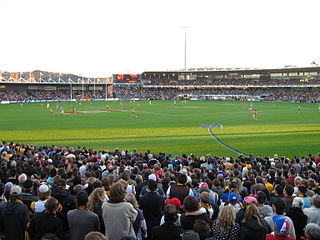
In Tasmania, Australian rules football is a popular spectator and participation sport. It has been played since the late 1860s and draws the largest audience for any football code in the state. A 2018 study of internet traffic showed that 79% of Tasmanians are interested in the sport, the highest rate in the country. It is governed by AFL Tasmania and according to Ausplay there are 13,927 adult players with a participation rate of 2.5% per capita about a quarter of which are female playing across 12 competitions.

In the Australian Capital Territory (ACT), Australian rules football is a popular spectator and participation sport which has been played continuously since 1911. It was the most popular football code in the nation's capital Canberra between 1978 and 1982 and has the second highest participation after soccer. The current governing body is AFL Canberra founded 1922, while the development body is AFL NSW/ACT established in 1999.

In the Northern Territory (NT), Australian rules football is a popular participation and spectator sport, particularly among the many remote Indigenous Australian communities of the outback such as the Tiwi Islands but also in the capital Darwin and other cities particularly Alice Springs. There are more than 15 regional competitions across the territory, the highest profile being the semi-professional Northern Territory Football League based around Darwin and Central Australian Football League around Alice Springs. It is governed by AFL Northern Territory. 7,158 adults and 3,917 children play it, of which about a third are female. Participation per capita has fallen from 18% in 2017 when it had the highest rate for a team sport in Australia to 3.4% in 2024 and fourth behind soccer, basketball and cricket.

In New South Wales, Australian rules football dates back to the 1860s colonial era, with organised competitions being continuous since the 1880s. It is traditionally popular in the outback areas of the state near the Victorian and South Australian borders— in the Murray Region, in the Riverina and in Broken Hill. These areas form part of an Australian cultural divide described as the Barassi Line. To the west of the line it is commonly known as "football" or "Australian Football" and to east of the line, it is promoted under the acronym "AFL" by the main development body AFL NSW/ACT. There are more than 15 regional leagues though some are run from other states, the highest profile are AFL Sydney and the Riverina Football Netball League. With 80,572 registered players, it has the third most of any jurisdiction.
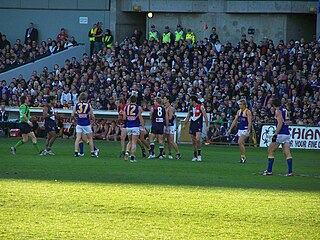
In Western Australia (WA), Australian rules football is the most popular sport. There are 29 regional club competitions, the highest profile of which is the semi-professional West Australian Football League. It is governed by the West Australian Football Commission (WAFC). It has 108,154 adult players and 46,187 children, the highest participation rate per capita (8.5%) in Australia, second most players of any jurisdiction, accounts for around a fifth of all players nationally and is growing faster than any other state. It is the third most participated team sport after soccer and basketball.

In Victoria Australian rules football is the most popular sport overall, being the most watched and second most participated code of football. Australian rules football originated in Melbourne in the late 1850s and quickly came to dominate in the sport, which it continues to. Victoria has more than double the number of players of any other state in Australia accounting for approximately 42% of all Australian players in 2023 and continues to grow strongly. In 2023 there were 76 competitions and 1,242 clubs. According to Ausplay there are 227,213 adult of which about one in three are female and 96,068 children playing, similar numbers to soccer. The sport is governed by AFL Victoria based in Melbourne. The national governing body, the AFL Commission is also based in Melbourne.
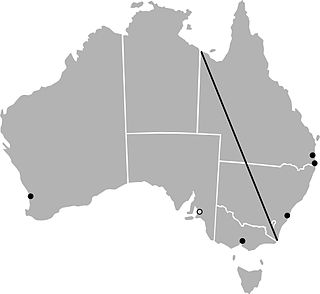
The Barassi Line is an imaginary line in Australia which approximately divides areas where Australian rules football or rugby league is the most popular football code. The term was first used by historian Ian Turner in his 1978 Ron Barassi Memorial Lecture. Crowd figures, media coverage, and participation rates are heavily skewed in favour of the dominant code on either side. Other sports are unaffected by the dichotomy; Australian cricket, for example, has maintained consistent national interest throughout its history.

The AFL Hall of Fame Tribute Match was a one-off all-star game between two representative sides organised by the Australian Football League to celebrate the 150th anniversary of Australian rules football. The match was intended to celebrate the contribution of State of Origin and interstate matches to the history of the code.
The AFL National Championships is an annual Australian national underage representative Australian rules football tournament. Since taking over as national governing body in 1995, the AFL has gradually restructured the competition into a primary junior pathway for its fully professional national club competition.

